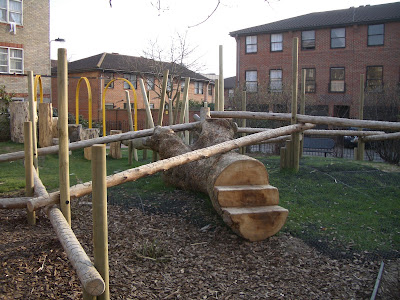


Still traveling through London by playground (can you believe I saw all this in one day?)
Given Martha Schwartz' reputation for the avant-garde, I was disappointed that her firm's playground for the redevelopment of St. Mary's Churchyard at Elephant and Castle consisted mostly of off-the-shelf components from a manufacturer, with the addition of some orange climbing blobs.
Very artificial, of course, but that is her style.
The flat 'discs' in the second photo are little marble sculptures, polished cool and smooth for tiny hands, with a recess in the top that would catch just enough water for a little splashing after a rain, but not enough to stay around and become stagnant. They were my favorite feature.
In the wider parkspace, black and white spheres sprouting up like so many mushrooms underneath a grouping of trees were surprisingly comfortable to sit on, and more playful than your average park seating.
More exciting, I think, are some other plans for the area...there is to be an 'urban forest' that will run from Elephant and Castle to the Tate Modern, and include a playground (drawing below from architects-in-charge Witherford Watson Mann). Can't wait!




















